3 Key Factors Make National Digital Transformation Successful








When the Prime Minister approved the “National Digital Transformation Program to 2025, with a vision to 2030,” national digital transformation became formally a goal shared by the entire Vietnamese people in 2020.
Since then, localities, ministries, branches, and even the government have all gradually incorporated the term “Digital Transformation” and applications of digital technology into their everyday activities.
Thus, we all realize the significance and impact of the digital transformation trend. What essential elements, nevertheless, determine the National Digital Transformation Program’s success or failure?
1. Overview
What is Digital Transformation?
The process of using digital technology to completely alter each person’s lifestyle, each company’s business model, and each nation’s government operations in order to create new values and prospects for future development is referred to as transformation, also known as digital transformation.
Today, all businesses, big and small, have to decide whether to embrace innovation or risk lagging behind, becoming ineffective, and going out of business.
Furthermore, digital transformation involves- not just comprehending and utilizing technology but, more importantly, reinventing the complete business strategy as well as the vision and development priorities of the nation in relation to the global development trend.

According to data from Mordor Intelligence, the digital transformation age is shining in practically “every nook” of the global economy, confirming that this is not a “soon to fade” trend but rather a new and sustainable development orientation following the pandemic crisis.
- The estimated value of the global market for digital transformation is $998.99 billion in 2022 and is expected to reach $2744.68 billion by 2026. The compound annual growth is 17.42%.
- Global spending on digital transformation is expected to reach $1.6 trillion by the end of 2022 and surpass $3.4 trillion by 2026.
- Over 90% of global businesses, both large and small, are adopting digital initiatives.
- 97% of business executives say the COVID-19 pandemic has spurred digital transformation efforts.
- 95% of startups have a digital business plan compared to 87% of traditional, established companies.
- According to statistics, currently, only 13% of jobs do not require digital skills, and 33% are jobs that require proficiency and advanced digital skills.
In Vietnam alone, the government has established a National Digital Transformation Program for 2025, with a vision to 2030, with particular targets to shorten the distance with other countries around the world, including:
- 80% of online public services at level 4 are performed on mobile devices.
- 90% of work records at ministerial and provincial levels are online while 80 percent of work records at the district level and 60 percent of work records at the commune level are processed online.
- All national databases including those for population, land, business registration, finance, and insurance are online and connected, with shared data on a government reporting information system.
- 50% of banking operations by customers are to be fully online.
- 50% of the population has a digital checking account.
- 70% of customer transactions are made through digital channels.
- 50% of decisions on lending, small and consumer loans of individual customers made digitally and are automated.
- The digital economy accounts for 20% of GDP.
- The rate of the digital economy in each industry, and each field accounts for at least 10%, and labor productivity increases by at least 7%.
- Vietnam is among the top 50 leading countries in information technology, the top 30 countries in innovation, and the top 50 countries on the competitiveness index.
- Fiber optic network infrastructure covers 80% of households and 100% of communes.
- Universalize 4G/5G mobile networks and use smartphones in remote areas.
- The percentage of the population with electronic payment accounts is over 50%
Why is Digital Transformation important?
The fact that the goals are stated in great detail in the national digital transformation program with a focus on 2030 demonstrates how seriously the Vietnamese government takes the significance of digital transformation for the prosperous growth of the nation.
Think about the global Industrial Revolution 4.0 wave that is currently in motion. With the aid of connection provided by the Internet of Things (IoT), real-time data access, and the introduction of cyber-physical systems, the Industrial Revolution 4.0, also known as Industry 4.0, primarily focuses on advancing modern digital technology to an entirely new level.
Every Government, organization, corporation, and individual throughout the world must transform its business model, and the manner of working from non-digital to digital operation, in order to keep up with this current technology and immerse itself in the Industry 4.0 wave. The name of this procedure is “digital transformation”.
Vietnam, despite having a minor economy compared to other countries, is a crucial part of the massive Industrial Revolution 4.0 that is currently underway. Vietnam must therefore undergo a digital transformation in order to compete.

The goal will be challenging to accomplish if just businesses execute digital transformation because the capital and costs are quite high; therefore, businesses require assistance from the government budget and outside finance.
On the other hand, even with a massive budget, it can be challenging for businesses to implement effective digital transformation if the government does not go digital, but continues to run in the old manner, handles administrative procedures slowly, lacks direction, and supports businesses clearly and methodically.
Furthermore, without the support of the people, the National Digital Transformation process to catch up with the global Industry 4.0 wave will be impossible. However, the public needs the government to inform, direct, and inspire digital transformation.
Also, businesses must create useful digital transformation strategies that both before and after implementation considerably raise people’s quality of life.
Vietnam must structure three main areas of digital transformation: the government, businesses, and people, or in other words, the digital government, digital economy, and digital society, if national digital transformation is the outcome it seeks to achieve in order to gradually join the Industrial Revolution 4.0.
These three crucial overlapping and interdependent relationships make up the National Digital Transformation.
The current state of Vietnam’s National Digital Transformation
Throughout the earlier years, Vinasa reports that in 2019, 40.6% of organizations and businesses confirmed that they have resources available for digital transformation and that 23.6% of them are putting it into practice. However, 30.7% of them are uncertain of what to do despite doing some research, and 38% are unsure of where to begin.
Due to the Prime Minister’s approval of the “National Digital Transformation Program to 2025, with a vision to 2030” and the abrupt change brought on by the impact of the global pandemic, Digital Transformation is now regarded as the process’ starting year. This makes it a top priority to maintain Vietnam’s economy.
The government and Vietnamese enterprises have been able to promote awareness of the importance and urgency of digital transformation in order to help the country overcome the obstacle thanks to the economic crisis brought on by the effects of the Covid-19 outbreak.
According to the UN, Vietnam’s digital government statistics are better than the average for the area. Vietnam specifically saw a rise of 2 places in 2020, moving up to rank 86th out of 193 UN member states globally and 6th out of 11 Southeast Asian nations.
The establishment of the National Digital Transformation Committee and the decision to appoint October 10 of each year as National Digital Transformation Day in accordance with the National Digital Transformation policy for a better life for the people are two additional significant events that will forever be remembered in Vietnam in the years 2021 and 2022.
As a result, leaders and people are more conscious of the significance, function, and advantages of digital transformation, and there are coordinated actions throughout the entire system, from the government to the general populace.
According to data from the Ministry of Information and Communications, the databases that Vietnam has built up to the second quarter of 2022 include:
- Citizen data: Approximately 78 million data including birth registration, marriage registration, death registration,…
- Social insurance data: Over 17 million records.
- Vaccination data: Over 133 million records.
- Data of officials and employees: Over 570,000 records.
- Citizen ID card with the chip: Nearly 72 million records.
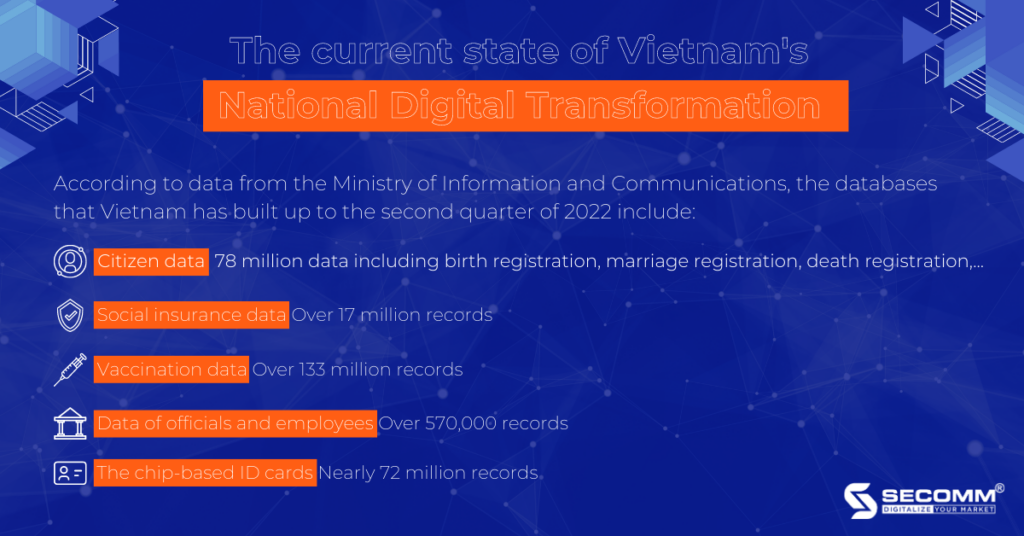
Additionally, the percentage of qualified online public services offered to individuals and enterprises has surpassed 97.3%; the percentage of these services that produce dossiers has gotten to 67.8% and the percentage of administrative procedures handled online has gotten to 43.2%.
Moreover, the economic sector has seen some very good improvements as a result of digital transformation. The Ministry of Information and Communications predicts that by the first quarter of 2022, the value of Vietnam’s digital economy will be 53 billion USD and that there would be 500 more newly founded digital technology businesses than there were at the same point in 2021.
The number of monthly users on Vietnamese mobile digital platforms climbed by more than 100 million compared to the same period in 2021, and the percentage of the digital economy in GDP increased to 10.41% in the first half of the year from 9.6% in the end of 2021.
2. 3 key factors make National Digital Transformation successful
Based on specific analysis and data on the situation of National Digital Transformation in Vietnam, it is clear that there are 3 main pillars that lay the foundation for the success of the National Digital Transformation process: Digital Government, Digital Economy, and Digital Society.
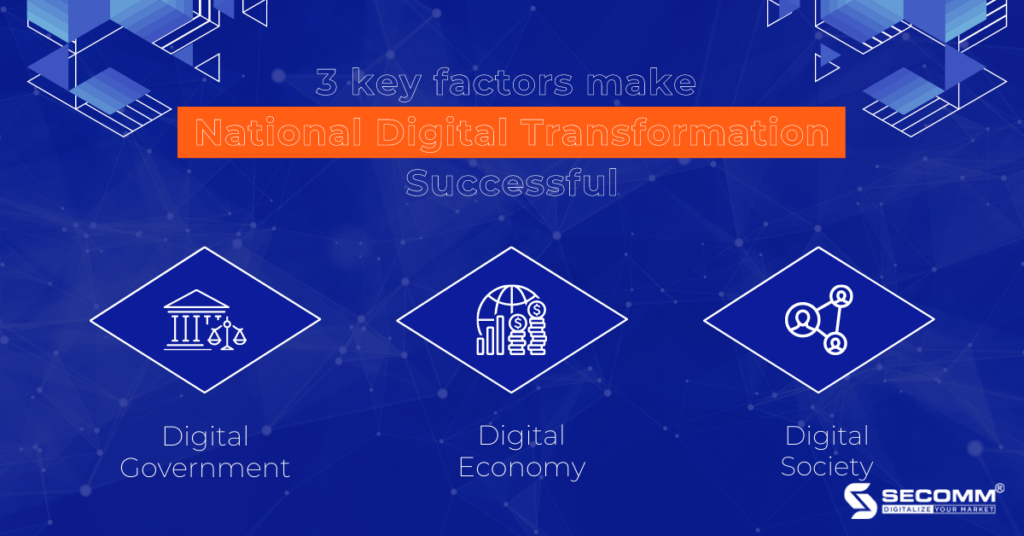
Digital Government
In order to increase operational efficiency and develop new operating models and alter the way services are offered using digital technology and data, a government must transition all of its operations to a digital environment. This allows enterprises to take part in the service delivery process. In other words, this is how the government is becoming digital.
Vietnamese citizens have been instructed in the past to finish the registration processes necessary to access the Citizen Identity Card with a chip, which is gradually replacing the previous ID card. This serves as one illustration of how well the digital government is progressing in Vietnam.
The process of processing dossiers and issuing ID Cards in the early stages is not really effective because the National Database on Civil is still under construction and staff training on how to use digital technology and digitize paper data on the data system is still limited. However, the procedure for issuing chip-based ID cards in addition to the cost is public and transparent.
As a result, when people arrive at the location where the chip-based ID card is made, processing will go more quickly if their information is already in the National Database; otherwise, they will need to provide more birth certificates and household registration information and will have to wait a long time for staff to check, enter data, and complete related procedures.
After that, the chip-based ID card will be sent to the registered address by post, but for the above reason, this process also takes quite a while.
The Public Service Portal of the Ministry of Public Security, however, is currently supported by the government and simply requires people to visit the location to capture pictures and fingerprints.
This demonstrates the government’s prompt responsiveness in streamlining business procedures while also saving time for both citizens and employees. This is evidence of the Government’s ongoing attempts to modernize itself digitally.
In addition, on the CCCD chip, more than 14 information fields of citizens are stored: (1) CCCD number; (2) Full name, other names; (3) Date of birth, month, and year; (4) Gender; (5) Nationality; (6) Ethnicity; (7) Religion; (8) Hometown; (9) Place of permanent residence registration; (10) Identification characteristics; (11) Date of issue; (12) Expiration date;
(13) Full name of parent, spouse; (14) issued 9-digit ID card number; (15) Portrait photos; (16) Features of fingerprint extraction and selection of two index fingers; backup for iris images, and other information.
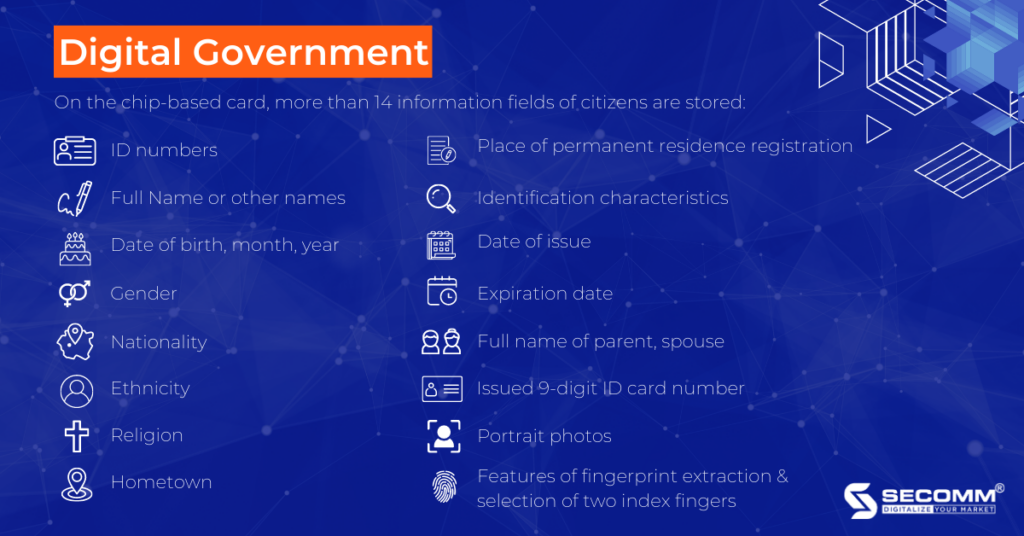
Moreover, a chip-based ID card can replace important papers such as Identity Cards, Health Insurance (HI), Social Insurance (Social Insurance), Birth Certificate, Marriage Certificate, and Household Registration Books….
It is clear that switching from conventional ID cards to chip-based ID cards has several advantages for both the general public and the government. People’s personal information is highly secure, preventing the creation of fake documents.
Also, ID cards with chips make paperwork and transactions straightforward because many pieces of crucial information are combined onto a single card, saving time and preventing the scenario where someone forgets to bring the necessary paperwork and causing the processing of documents to be interrupted.
The government made a wise choice by implementing chip-based ID cards.
The government can save, control, and check information about a specific individual quickly and efficiently with the use of chip-based ID cards and the National Database, helping to effectively control the situation of local security and order as well as national security.
Also, this helps free up labor for government employees who deal with people, handle paperwork, and maintain correctness, speed, and synchronization.
Digital Economy
The second factor that makes the success of the National Digital Transformation process is the Digital Economy.
Digital Economy is an economy that maintains and develops constantly based on modern digital technology. The digital economy is also known as the Internet Economy, the New Economy, or the Web Economy. This particular economy is made up of electronic transactions over the internet.
According to the definition from the Vietnam Private Economic Forum, the digital economy is all economic activities based on digital platforms. Digital economy development is the use of digital technology and data to create a new model of cooperation and business, in line with the development trend of modern technology.

Therefore, everyone would immediately think of eCommerce when discussing the digital economy or the most prominent business model of the trend of digital transformation, and the strong push that this industry provides for high-volume industries catches the trend of digital transformation.
Few people anticipate that the conventional market model, which has become ingrained in Vietnamese culture, would soon be replaced by the market model 4.0, which accepts cashless payments. In several of Hai Phong’s traditional markets, this novel method of buying and selling was introduced for the first time, to the delight of the locals.
The Viettel Money application of Viettel Military Telecom Group, a pioneer in the digital transformation of market 4.0 models in 63 provinces/cities, enables all small businesses and individuals to purchase and sell things at the market by scanning QR codes or transferring money via phone number.
Moreover, cashless payment makes it easier for customers to shop at the market without worrying about issues like carrying change or budgeting extra cash for purchases. Also, many shopkeepers in the market are afraid of this issue pretty much.
Previously, if customers paid in cash with a denomination that was too big, shopkeepers would have to run everywhere to change money, causing time-consuming for both parties and other customers waiting to be served, the issue is now solved with just one smartphone.
Following the success of Hai Phong’s 4.0 market model, many other localities have also implemented this model and received positive feedback signals from the people such as Da Nang, Quang Ninh, Thai Nguyen, Lang Son, etc.
The market 4.0 model has spread to every nook and cranny of the nation’s small trading places, including farmers’ markets, grocery stores, sidewalk shops, amusement parks, parking lots, and more.
The digital transformation trend has quickly extended to places where it was previously impossible, helping to advance the digital economy and achieve the objective of a comprehensive national digital transformation.
Digital Society
Finally, the term “digital society” refers to all human activities in a broad sense. Digital technology, which is based on the exponential growth of information and data, is the primary driver behind digital society.
It transforms all facets of social structure, from the government and business to the individual. In a limited sense, “digital society” refers to both digital citizenship and digital culture.
From this perspective, the three pillars of a digital nation are the digital society, the digital government, and the digital economy.
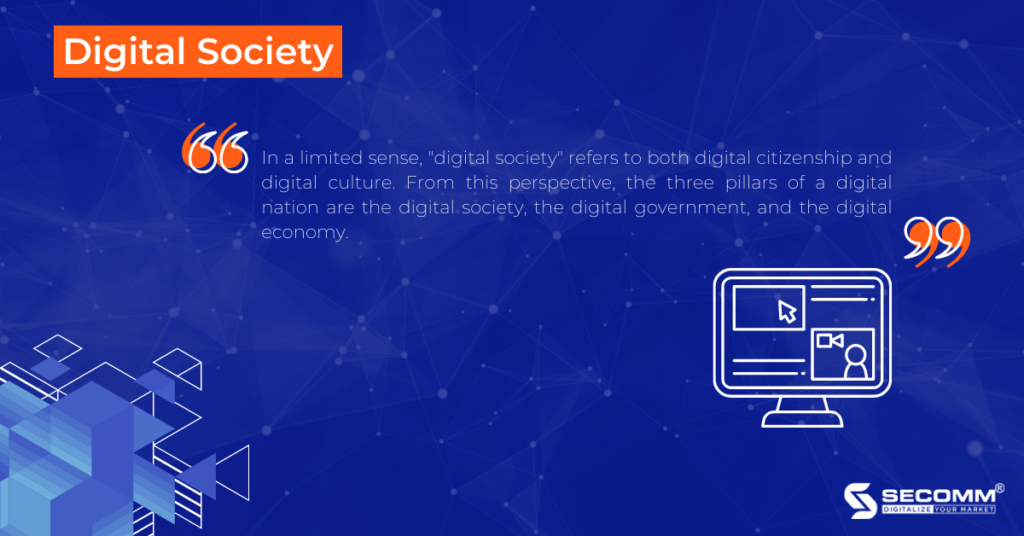
Teachers, parents, and students all adore the eLearning model, which is developing into a popular teaching and learning trend, especially in light of the recent pandemic and widespread implementation of social distancing policies.
Students can access lessons at any time, studying at home, using simply an electronic device with an Internet connection. As a result, teachings can be discussed and interacted with by professors and students without them having to actually meet.
This model also supports student doing teamwork well because it is not time- or space-constrained, saving on travel expenses in addition to using many other helpful resources.
However, for eLearning to really replace traditional teaching and learning methods, it takes a lot of effort from both the Government, the school system, and the student’s parents.
In fact, eLearning is only a small part of the digital society effort besides many other important aspects of society that need to be digitally transformed to make life more convenient for people.
National Digital Transformation has become one of Vietnam’s top goals and this is also a rare project that has received special attention from the highest levels of leadership and international support. Since then, Vietnam has had a full foundation to hope to realize the goal of becoming a digital country from now to 2030.
The development of a digital society, economy, and government, in particular, is a necessary and sufficient condition for a successful national digital transformation.
In fact, every citizen, from intellectuals to regular citizens, is gradually demonstrating a certain understanding in their own way about the digital transformation and awareness that the country is in a transition period to match the general development trend of the times.
This is in addition to the efforts of businesses and the support from the government.
Especially for businesses, digital transformation is an imperative remedy to withstands to withstand the tsunami of eradication brought on by the pandemic’s rapid shift in new business patterns.
Following Covid-19, business digital transformation flowed slowly, gently, and steadily, assisting the economy’s continued rotation.
The first step of the digital transformation journey for businesses is to start implementing eCommerce.
With many years of experience in successfully implementing eCommerce for many customers in many countries, SECOMM specializes in providing consulting services with comprehensive and professional eCommerce implementation solutions.
Contact SECOMM today for free support and advice.



















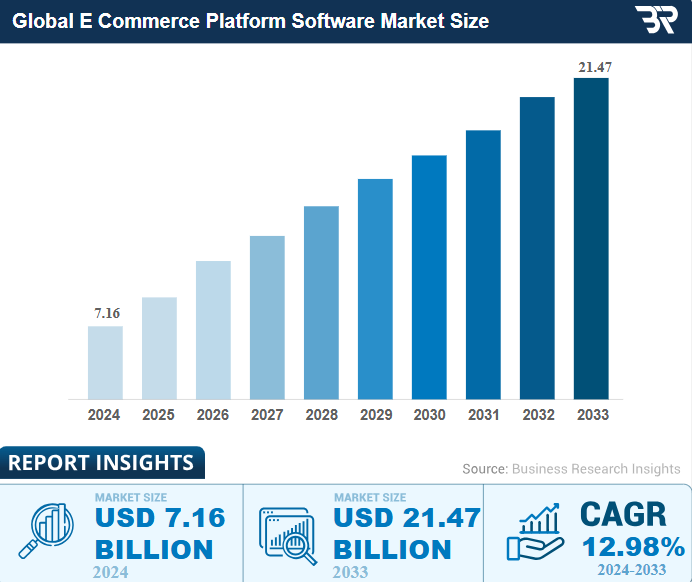


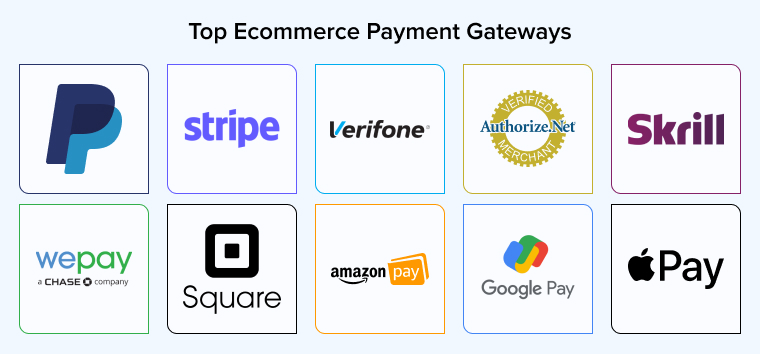




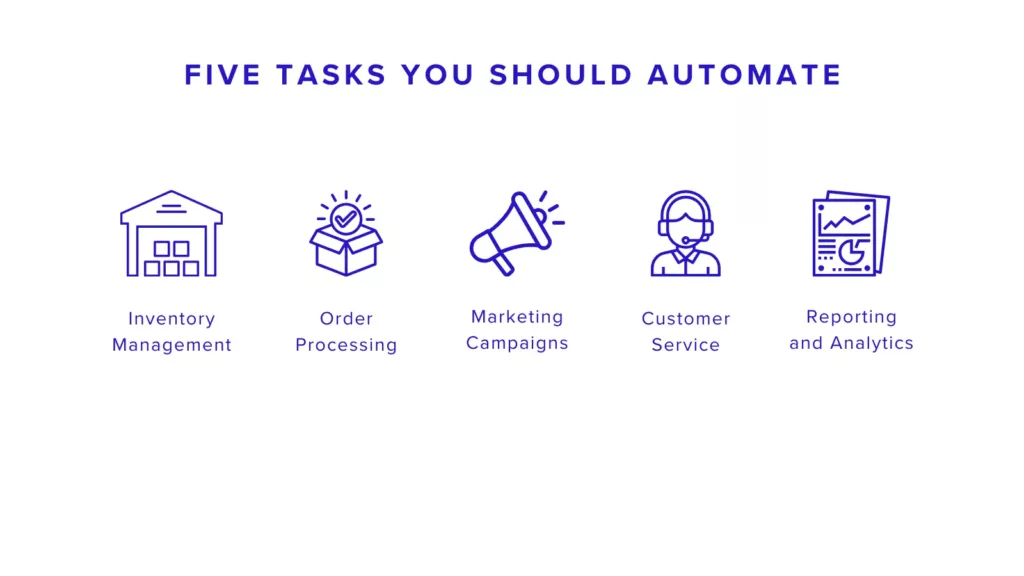
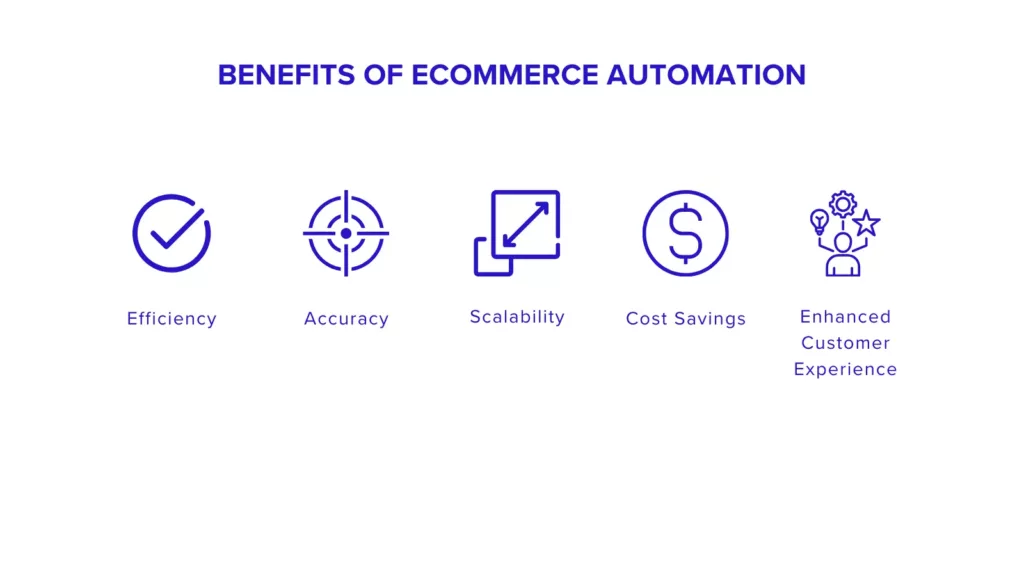
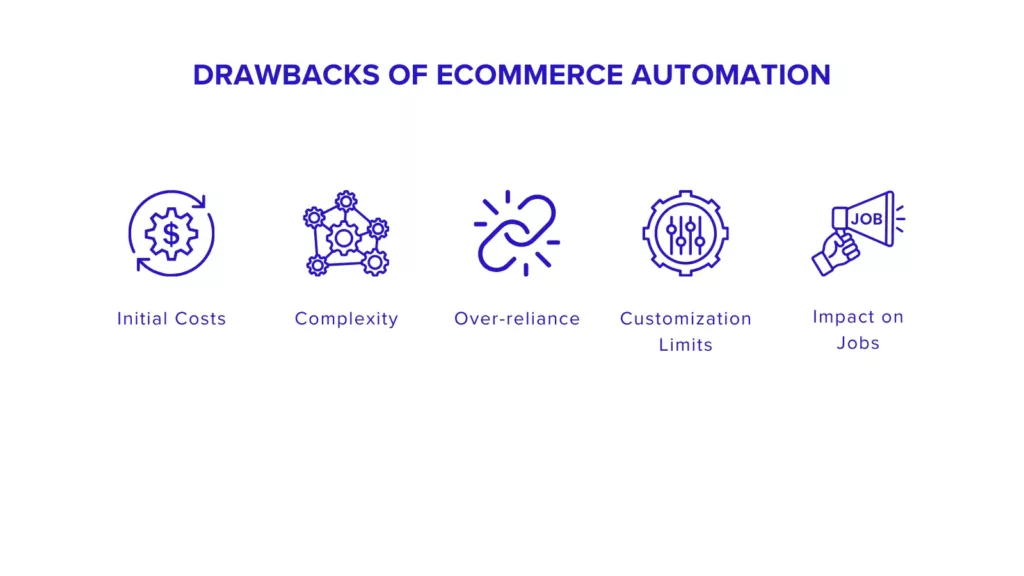



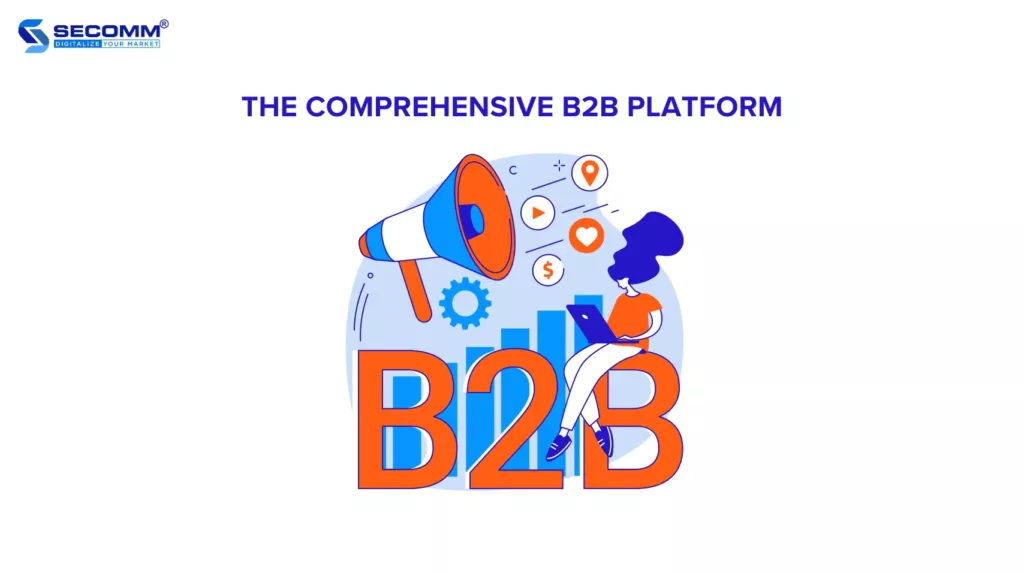
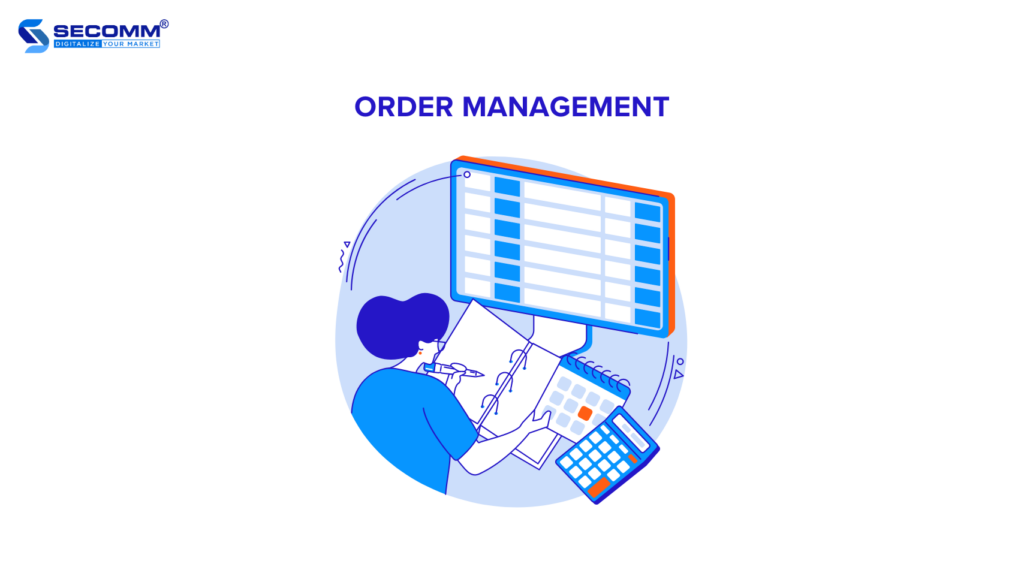










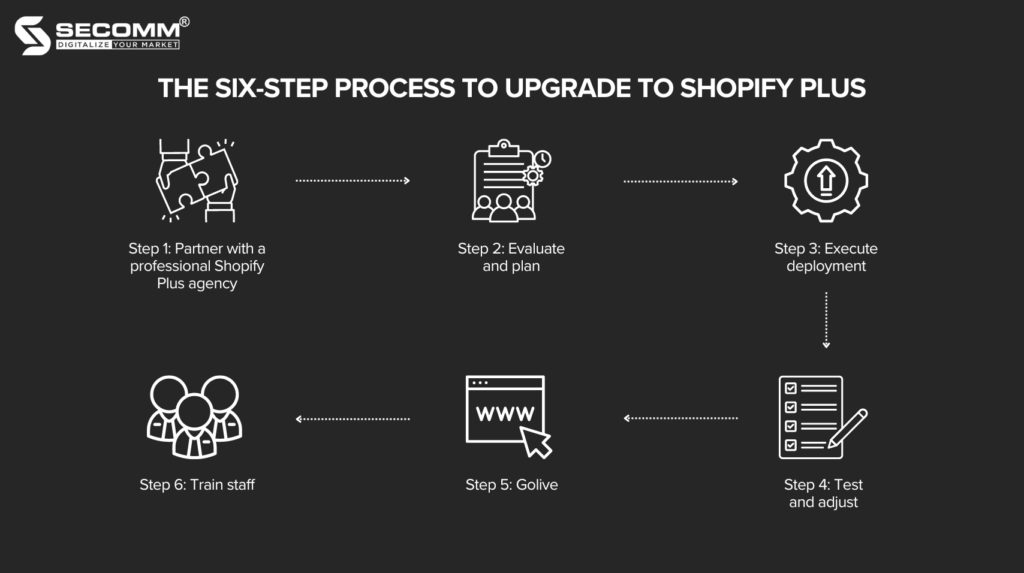





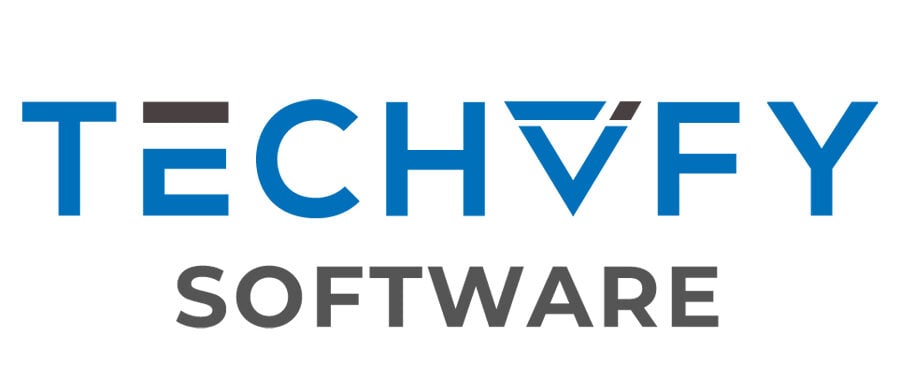



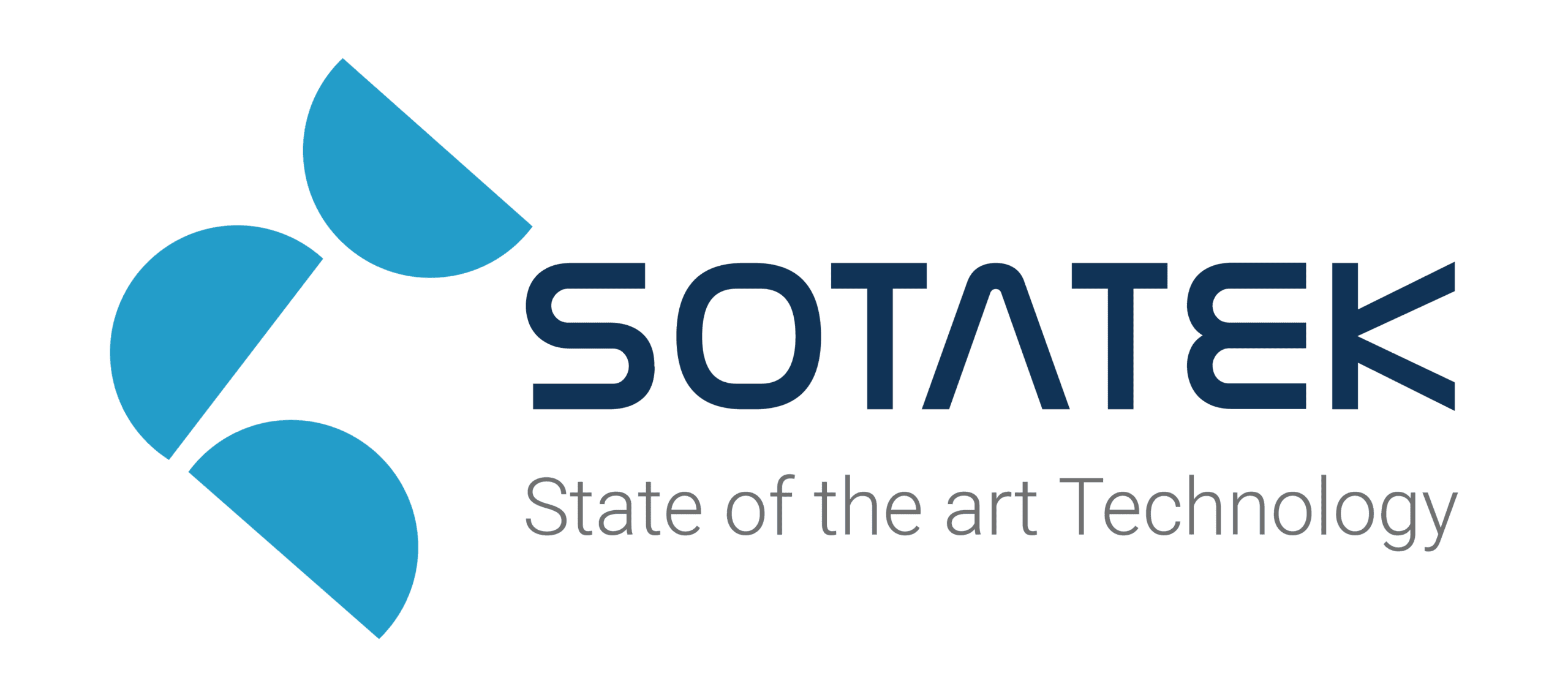












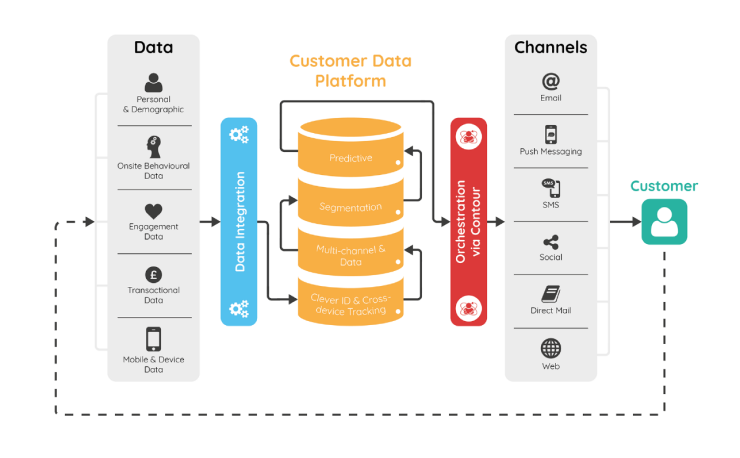










































Comment (0)